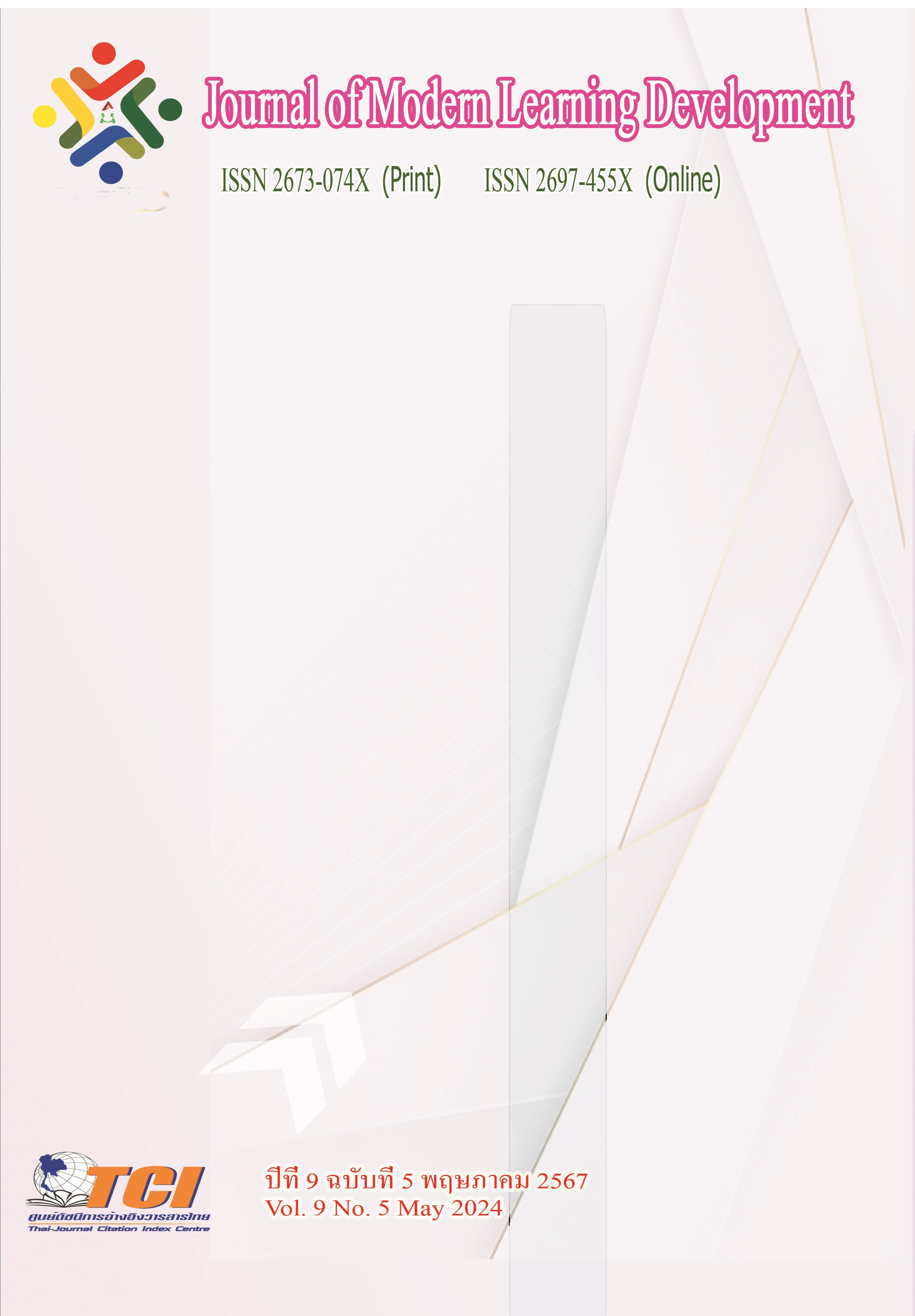Participatory community forest management between government and civil society to lead to sustainability : Case Study of Ban Pi Community Forest, Wiang Subdistrict, Chiang Kham District, Phayao Province and Ban Pong Community Forest, Ta Pha Mok Subdistrict, Long District, Phrae Province
Main Article Content
Abstract
The objective of this research was to study: 1. Study the characteristics of participatory management between the government and civil society to contribute to the sustainability of Ban Pi Community Forest. Chiang Kham District, Phayao Province, and Ban Pong Community Forest, Long District, Phrae Province, which has resulted in success in becoming a model community forest. 2. Transformational leadership characteristics of community leaders who make a difference to community forests lead to the sustainability of community forests. 3. Characteristics of capital affecting the success of participatory management for the sustainability of community forests, and 4. Positive impacts on sustainable development resulting from participatory community management of community forest areas. The specific sample is Ban Pi Community Forest. Moo 1 and Moo 10, Wiang Sub-district, Chiang Kham District, Phayao Province and Ban Pong Community Forest Moo 3, Ta Pha Mok Subdistrict, Long District, Phrae Province Specific groups of informants consist of government informants. A total of 14 people from the Department of Forestry, Ministry of Natural Resources and Environment and 30 civil society informants from the community collected data using field research methods by collecting data by means of in-depth interviews and focus groups. Use qualitative research methodology as the main guideline. Component analysis from the conceptual framework to find relationships in 4 aspects: Variable elements Aspect 1 is the process of participation between the government and civil society. The second variable element is that plays an important role in creating change in the community forest area. Aspect 3 is the capital model for community forest management and variable elements. Aspect 4 is the positive impact on sustainable development of community forest areas
The results of the research were as follows: 1. Participatory management between the government and civil society to contribute to the sustainability of Ban Pi Community Forest. Chiang Kham District, Phayao Province, and Ban Pong Community Forest, Long District, Phrae Province, where success in becoming a model community. There are 4 types of participation: 1) participation in decision-making, 2) participation in operations, 3) participation in utilization, 4) participation in evaluation. 2. Transformational leadership of community leaders who make a difference in Ban Pi Community Forest, Chiang Kham District, Phayao Province and Ban Pong Community Forest, Long District, Phrae Province Contribute to the sustainability of community forests Leadership traits with 4 key attributes: 1) ideological influence, 2) motivation, 3) intellectual stimulation, 4) consideration of individuality, 3. capital that affects the success of participatory management for the sustainability of Ban Pi Community Forest. Chiang Kham District, Phayao Province, and Ban Pong Community Forest, Long District, Phrae Province. There are 5 types of capital in community forest management: 1) human capital, 2) social capital, 3) natural capital, 4) physical capital, 5) financial capital, 4. Positive impact on sustainable development caused by participatory community management of Ban Pi Community Forest. Chiang Kham District, Phayao Province, and Ban Pong Community Forest, Long District, Phrae Province, found that the positive impact on sustainable development of community forest areas. There are 4 key dimensions: 1) cooperation in the efficient use of resources to achieve the desired goals, 2) jointly ensuring conservation, restoration and use of ecosystems, 3) participation in sustainable community forest management, and 4) jointly ensuring sustainable food production systems in accordance with agricultural practices that do not affect the environment.
Article Details
References
ปาณิสรา ตรัสศร. (2559). ภาวะผู้นำการเปลี่ยนแปลงของผู้บริหารองค์กรปกครองส่วนท้องถิ่นในเขตอำเภอ เขาวง จังหวัดกาฬสินธ์ุ. วิทยานิพนธ์ปริญญารัฐประศาสนศาสตรมหาบัณฑิต สาขาวิชารัฐประศาสนศาสตร์: บัณฑิตวิทยาลัย: มหาวิทยาลัยราชภัฏมหาสารคาม.
พรเทพ ศรีธนาธร. (2552). การจัดการป่าชุมชนอย่างยั่งยืนในการพัฒนาท้องถิ่น: การปฏิบัติของชุมชน ประชาชน การมีส่วนร่วมและความสำเร็จของการอนุรักษ์ป่า. วารสารการจัดการป่าไม้. 4 (8), 74-91.
สำนักงานปกครองท้องที่. (2563). ข้อมูลพื้นฐานการปกครองท้องที่. ออนไลน์. สืบค้น 23 มิถุนายน 2564. แหล่งที่มา: https://multi.dopa.go.th/pab/news/cate9.
อรุณี อินเทพ. (2564). แนวทางการพัฒนากระบวนการมีส่วนร่วมเพื่อยกระดับการจัดการท่องเที่ยวชุมชน : กรณีศึกษาชุมชนศรีดอนชัย อำเภอเชียงของ จังหวัดเชียงราย. ดุษฎีนิพนธ์ฉบับนี้เป็นส่วนหนึ่งของการศึกษาตามหลักสูตรปรัชญาดุษฎีบัณฑิต สาขาวิชารัฐประศาสนศาสตร์ สถาบันรัฐประศาสนศาสตร์และนโยบายสาธารณะ. บัณฑิตวิทยาลัย: มหาวิทยาลัยรังสิต
ปทุมธานี.อุไรวรรณ แมะบ้าน. (2563). การบริหารจัดการทุนทางสังคมเพื่อการพัฒนาชุมชนในรูปแบบชุมชนพึ่งตนเอง กรณีศึกษาในเขตพื้นที่ภาคเหนือตอนบนของประเทศไทย. ดุษฎีนิพนธ์ฉบับนี้เป็นส่วนหนึ่งของการศึกษาตามหลักสูตรปรัชญาดุษฎีบัณฑิต สาขาวิชารัฐประศาสนศาสตร์ สถาบันรัฐประศาสนศาสตร์และนโยบายสาธารณะ. บัณฑิตวิทยาลัย: มหาวิทยาลัยรังสิต ปทุมธานี.
Bass, B.M. & Avolio, B.J., (1994). Improving Organization Effectiveness Through Transformational Leadership. (Thousand Oak: Sage).
Carney D, et al., (1999). “Livelihood Approaches Compared” DFID, London : UK.
Cohen, J.M., & Uphoff, N.T. (1981). Rural Development Participation: Concept And Measure for Project Design Implementation and Evaluation: Rural Development Committee Center for international Studies. New York : Cornell University Press.
The Department for International Development. (1999). SUSTAINABLE LIVELIHOODS GUIDANCE SHEETS.


